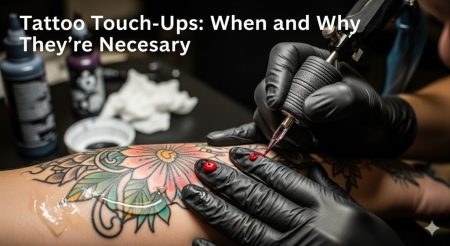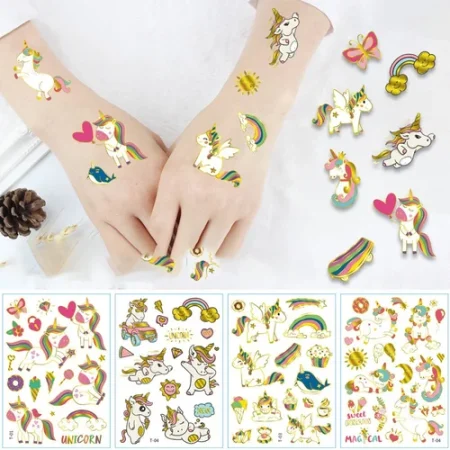Google’s research initiative SkinMarks examines how tattoos might become digital touchpoints. The fundamental concept is to develop tattoos that function as digital device interfaces using conductive ink and other technologies.
The body provides many recognizable landmarks due to the underlying skeletal structure and variations in skin texture, elasticity, and color. The visual and spatial cues of such body landmarks can help in localizing on-body interfaces, guide input on the body, and allow for easy recall of mappings. Our main contribution are SkinMarks, novel skin-worn I/O devices for precisely localized input and output on fine body landmarks. SkinMarks comprise skin electronics on temporary rub-on tattoos. They conform to fine wrinkles and are compatible with strongly curved and elastic body locations. We identify five types of body landmarks and demonstrate novel interaction techniques that leverage SkinMarks’ unique touch, squeeze, and bend sensing with integrated visual output. This technology also has potential applications in Digital Sports, where precise on-body feedback and interactive controls can enhance performance tracking, training, and immersive gaming experiences. Finally, we detail on the conformality and evaluate sub-millimeter electrodes for touch sensing. Taken together, SkinMarks expands the on-body interaction space to more detailed, h
Here, we look into how people could touch or swipe their tattoos to operate digital gadgets like smartphones or wearables. Let’s dive into the blog to discover more about this change.
What is SkinMarks Technology?

The SkinMarks project investigates the use of haptic feedback, which would enable individuals to experience digital sensations like pressure or vibrations through tattoos. It might be applied to other gaming or virtual reality applications and provide an engaging experience.
The SkinMarks project, which offers a glimpse of tattooing and incorporates digital technology, is still in the research and development stage. It’s crucial to consider technology’s effects and ensure that digital tattoos may be utilized appropriately.
Precise Touch Input on Skin Microstructure Landmarks
Body landmarks can be small and still very beneficial for onbody interaction. Our temporary tattoos allow for precise application on the landmark and for precise touch elements. This allows for sensing touch input exactly on the location of a tiny landmark to use its tactile properties.
We demonstrate this with a new interaction technique that makes use of tactile skin surface-structure.
The Wrinkle Slide interaction technique. A touch sensor augments one or multiple flexure lines (the larger wrinkles) on a finger. By sliding along the flexure line, the user can continuously adjust a value. A selection can be made by tapping. The precise tactile cues of the flexure line allow for tactile localization and guide the user during sliding, without requiring visual attention.
The technique also allows for one-handed input using the thumb of the same hand (thumb-to-finger input). Therefore, it can support interactions in busy mobile scenarios, e.g., while running. We demonstrate its use as a one-handed remote to control the volume of a mobile music player.
SkinMarks Components
The various elements listed below are utilized to create SkinMarks:
- Conductive Ink
One key element of SkinMarks is a conductive ink, which enables the tattoo to serve as a touch interface. It works like a circuit because it contains metal particles that can conduct electricity. Similar to how tattoo ink is applied to the flesh with a needle and ink gun, ink is used.
- Sensors
SkinMarks cannot function without its sensors, which enable the tattoo to recognize touch and other inputs. The tattoo design on the skin next to the tattoo may contain these sensors. The sensors in the tattoo detect touch or swipe information and send a signal to a digital device.
- Software
The last part of SkinMarks is software, which enables the tattoo to interact with digital devices and carry out certain tasks. Depending on the functionality sought, the software can be configured to respond to different inputs in various ways.
Ensure you thoroughly built and tested the technology to see whether it is secure, efficient, and easy to use.
What are the Advantages of SkinMarks Technology?
As we all know, this technology is still in the research and development stage. The following benefits and distinctive qualities set temporary tattoos apart from classic tattoos.
- Interactive Activity
Users and digital gadgets can interact through the usage of SkinMarks. Users can use various digital features by stroking or swiping the tattoo, such as playing music or snapping pictures.
- Enhancing functionality
SkinMarks can be created to carry out particular actions, such as opening a door or operating a device, making daily activities more convenient.
- Accessibility
People with disabilities may find SkinMarks useful as an alternative manner of controlling a digital gadget.
- Personalization
SkinMarks can be created to reflect the user’s personality, interests, and preferences to give a special and individual touch.
SkinMarks Design and Creation Process
The essential actions for developing and designing SkinMarks at this phase include:
- Conceptualization
Developing the design concept is the initial phase in the creation of SkinMarks. It would be based on a particular function, design, or a combination of the two.
- Design
The design process starts after you have developed the concept. Using applications like Adobe Illustrator or Photoshop, create a digital mockup of a tattoo design. The functional standards should be carefully considered while selecting any method.
- Prototyping
After the design is complete, the prototype phase will begin. Printing the image onto temporary tattoo paper and testing it to ensure it works as planned are both required.
- Production
Using conductive ink and conventional tattooing methods, SkinMark can be created when the prototype has been tested and improved. It is crucial to ensure the tattoo is done properly and the sensors are functional.
- Testing
It is important to test SkinMark after application to ensure it works properly. Connecting it to digital devices or trying it for haptic feedback is also involved.
- Refining
TheSkinMark needs to be improved or modified based on user input or testing. Changing the layout, moving the sensors, and updating the software.
What Interactive Activities Are Made Possible By SkinMarks?
Diverse interactive experiences that are tailored to various industries and applications’ needs are made possible by SkinMarks technology. Here, we’ve described some of the interactive activities made possible by SkinMarks:
Electronics Control
SkinMarks can operate electronic gadgets like smart home appliances, wearables, and smartphones. For instance, a SkinMark tattoo can be used to change the channel on the television, change the volume on a music player, or modify the temperature on a smart thermostat.
Virtual reality and gaming
SkinMarks can improve gaming and virtual reality experiences by offering haptic feedback and other interactive elements. For instance, a SkinMarks tattoo can increase immersion in virtual reality games.
Individualized Messaging
Based on user preferences, SkinMarks can send customized messages or offer comments. Depending on the user’s interests, skinMark tattoos could deliver personalized product recommendations or motivating messages to read while exercising.
Future Potential and Developments
SkinMarks’ potential and upcoming developments are fascinating and diverse. The following are some potential directions for the development and advancement of SkinMarks technology:
- Higher-quality sensors
- Haptic feedback that reacts quickly
- Improved compatibility with digital devices
The integration of technology with other new technologies includes:
- Combined reality
- Virtual world
- Biological sensors
You would realize how advanced and fascinating SkinMarks’ technology is. It is crucial to think about the privacy implications of SkinMarks as technology develops and to make sure that technology is used sensibly and in a user-friendly way.
Bottom Line
By creating an interactive experience, the SkinMarks-related elements we have gathered can modify both the physical and digital worlds. The technology behind SkinMark is redefining several different sectors.
FAQs for SkinMarks
- What is SkinMarks?
SkinMarks are temporary tattoos that contain conductive ink and electronic sensors. They can have haptic feedback, digital device control, and health data monitoring.
- How do you apply SkinMarks?
The same method was used to apply traditional temporary tattoos—SkinMarks—to the skin. Clean the area with soap and water before applying the SkinMark. The tattoo is firmly applied to the skin and left there for several seconds.
- What possible uses are there for SkinMarks?
There are numerous possible uses for SkinMarks in entertainment, medicine, marketing, instruction, and sports. They can combine the actual and digital worlds by developing interesting, tailored experiences.
- Are SkinMarks customizable?
SkinMarks are adaptable so that they can consider each user’s particular preferences and requirements. It features specialized haptic feedback, bespoke messaging, and specialized designs.
- How are SkinMarks taken care of?
Baby oil or adhesive tape both work well for removing skin marks. To remove the glue from the tattoo, apply tape or oil and gently rub it circularly.






